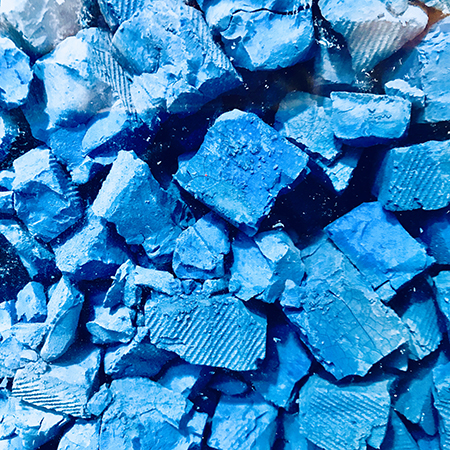PIGMENTS, DYES AND LAKES

In the 1960’s science fiction movie Fantastic Voyage a submarine crew is shrunk to a microscopic size and sent into the body of an injured scientist to repair his brain. It’s a marvellous film that lives up to its title, as our crew face numerous adventures and encounter a microscopic world of red cells, white cells and antibodies, eventually reaching and healing the tumour of their patient’s brain. It beautifully depicts – in a scale relatable to the human body – what this world might look like. To understand the difference between pigments, dyes and lakes, we need to climb onto Fantastic Voyage’s ship and observe these colour elements at a microscopic level – or at least – the way they behave as paints.
Beginning with pigments it’s important to observe how at a microscopic level pigments are dispersed – or suspended – in a medium (gum Arabic, linseed oil, or acrylic polymer emulsion). Imagine microscopic particles floating in their chosen medium; so many they resemble one entity (paint), when in fact, we are looking at two elements: pigment and binder. If this is hard to visualise imagine lots of Jeff Koon’s ‘basketballs’ floating in a tank; where the basketballs are pigment, and the liquid in which these float; the medium. That is the closest you’ll get to see paint at a microscopic level other than climbing onto Fantastic Voyage’s ship (or using a microscope). The second important observation is that these pigment particles come in all shapes and sizes. They are rarely as even in shape as basketballs and you would not believe the myriad of patterns and shapes they come in. Some are hollower, some pretty solid and others flatter in shape. This accounts for the reason some pigments are heavier than others and, importantly, the reason some colours are more transparent and others more opaque. The more tightly packed or dense its molecular structure is, the more opaque a colour will be, and the more it is composed of flat or hollow microscopic particles, the more transparent a colour will be. This is by admission a very unscientific way to describe pigments, but one which hopefully will explain the reason light is able to travel through certain colours or ‘glazes’.
Whilst pigments ‘float’ in a medium, dyes ‘dissolve’ (usually in water), becoming a homogenous solution. Much like the way there are many types of pigments (organic, inorganic and their synthetic versions), there are many types of dyes. Traditionally these were obtained from plants and root vegetables, but since 1865 many more have been widely available after the invention of mauveine by William Henry Perkin, who, in an attempt to synthesise quinine, discovered this first of synthetic dyes.
Both dyes and pigments work by absorbing certain light wavelengths and reflecting the rest – however their crucial difference is that dyes undergo molecular changes through this process causing them to ‘fade’. The fate of a dye molecule fading is difficult to observe – even with the help of our Fantastic Voyage’s submarine. Dye molecules absorbs a photon, exciting an electron to a higher energy state, and, as the molecule de-excites giving off heat and returning to its ground state, it often undergoes a chemical changes to its electronic structure, affecting the molecule and its ‘light’ absorption properties. Confusing as it may sound, dyes can be altered to become permanent lightfast pigments called ‘lake pigments’ by precipitating dyes and become ‘insoluble’ pigments that can be dispersed and suspended in a medium just like any pigment.
Today around eight million tons of pigments are marketed worldwide. Some of these pigments will end up in industrial paints, the automotive industry and even household items such as a washing machine, but only ‘artist quality’ pigments undergo rigorous tests to ensure that A and AA rated colours will last, not fade, tarnish or alter their hue.

